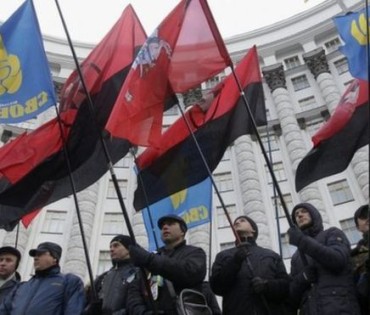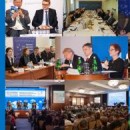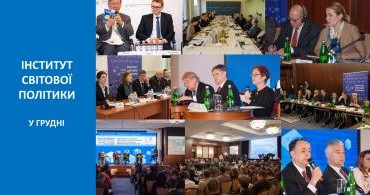Adrian Karatnycky, Member of the IWP’s Supervisory Board, for the Wall Street JournalOriginal of the articleAs Russia turns its attention to attacking the rebels in Syria, its simmering war with Ukraine has lately enjoyed a bit of a lull. But Kiev isn’t letting its guard down. It’s taking this opportunity to integrate the country’s far-right military groups into its regular armed forces, steeling itself against the possibility of Russian campaign of internal destabilization.
Under normal conditions, this would be cause for alarm. Ukraine’s far-right groups include “social nationalists” and politically marginal white-supremacist groups, extreme nationalists who preach “Ukraine for Ukrainians.”
Yet given the constant threat of Russian-backed aggression, even leaders from Ukraine’s far right understand that radical action now would be suicidal for the state. As a result, some are cooperating with the integration process, thus dampening the danger these groups might otherwise have posed.
Ukraine’s far right became a growing presence in the country after the ouster of President Viktor Yanukovych in January 2014. Far-right activists were on the Maidan during the mass protests. Their volunteer militaries, which emerged after the Russian invasion of Crimea as part of a broader volunteer movement that included many nonrightist armed groups, were integral to defending against Russian aggression in Crimea and the eastern Donbas region.
Battlefield heroism bolstered their reputation. From a small cohort of far-right adherents, the groups expanded into larger amalgamations that united hundreds of well-provisioned fighters with thousands of volunteers who raised funds and built political support.
When Ukraine’s democratic leaders came to power in January 2014, they found the country’s armed forces unreliable and disorganized. There was no choice but to make common cause with the many highly motivated volunteer battalions in the country, including those that came from the ideologically incompatible far right.
As presidential and parliamentary elections have shown, Ukrainians remain overwhelmingly opposed to the far right’s political message. Yet President Petro Poroshenko has always remained wary about the far right’s disruptive potential. Some of these groups were said to have long been infiltrated by Russian agents and financed by allies of Mr. Yanukovych.
A spate of rightist vigilantism over the past year has also raised alarms. Politicians from the old regime have been beaten. Russian and separatist prisoners captured in the Donbas conflict have been tortured. The pro-Russian writer Oles Buzyna was murdered in Kiev, and activists linked to the nationalist Svoboda Party and the far-right Ukrainian National Assembly have been charged. The groups and those arrested have denied the charges.
In August, a member of Svoboda threw a grenade at the Ukrainian militia during a protest outside the Parliament, killing four militia guards and wounding more than 100 law-enforcement personnel.
The volunteer militias also posed a further unique challenge. As multilateral negotiations with Russia and its proxies gained steam, there was concern in Kiev that these right-wing forces would refuse to respect a cease fire.
All this suggested a mounting threat to order and stability.
In response, Mr. Poroshenko chose to develop a controversial but pragmatic strategy aimed at integrating the far right. His policy had four aims: to attenuate the ideological influence of the far-right among the volunteer forces; to channel the esprit of the volunteers into disciplined energy inside the regular armed forces and national guard; to re-establish control over the many weapons the fighters possess; and to remove these far-right forces from the front line and replace them with regular forces who can be a reliable part of the chain of command.
Over the past half year, volunteer units have gradually been removed from the front lines and integrated into the army and national guard. Fighters with criminal histories have been demobilized. In their stead, professional soldiers have been blended into the volunteer units, which have been rebranded as regular army and militia units.
While residual loyalty to their ideological and volunteer forebears remains, most of these former volunteer units are now under the direct command of career officers. They are deployed alongside members of Ukraine’s security service and counterintelligence, who not only supply the fighters with military intelligence, but can watch for potentially seditious internal activity.
There are some risks to this strategy. Nothing guarantees that some fighters from the far right won’t one day once again answer the call of their far-right leaders. The presence of rightists in the ranks of Ukraine’s military also gives superficial credibility to the Kremlin’s preposterous claims that ethnic Russians and Russian speakers are at risk in “fascist” Ukraine.
On balance, however, Mr. Poroshenko’s strategy is gradually making gains. He has rebuilt Ukraine’s regular armed forces, with 40,000 well-armed, well-trained and reliable soldiers today deployed on the front lines—a force more than 30 times larger than that of the various far-right groups.
Matched by some progress in economic reforms and a reversal of economic decline, this means Ukraine is moving toward greater stability. For Russia’s President Vladimir Putin, Kiev’s newfound resilience, coupled with Western sanctions, may be one reason why he spent so little time last week at the United Nations General Assembly talking about Ukraine, and why he wants to change the subject through his massive intervention in Syria.




Comments theme
Comments themeComments themeComments themeComments themeComments themeComments themeComments themeComments themeComments themeComments themeComments themeComments themeComments themeComments themeComments themeComments themeComments themeComments themeComments themeComments.